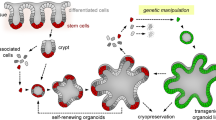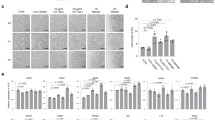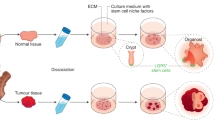Abstract
This protocol describes the isolation and characterization of mouse and human esophageal epithelial cells and the application of 3D organotypic culture (OTC), a form of tissue engineering. This model system permits the interrogation of mechanisms underlying epithelial-stromal interactions. We provide guidelines for isolating and cultivating several sources of epithelial cells and fibroblasts, as well as genetic manipulation of these cell types, as a prelude to their integration into OTC. The protocol includes a number of important applications, including histology, immunohistochemistry/immunofluorescence, genetic modification of epithelial cells and fibroblasts with retroviral and lentiviral vectors for overexpression of genes or RNA interference strategies, confocal imaging, laser capture microdissection, RNA microarrays of individual cellular compartments and protein-based assays. The OTC (3D) culture protocol takes 15 d to perform.
This is a preview of subscription content, access via your institution
Access options
Subscribe to this journal
Receive 12 print issues and online access
$259.00 per year
only $21.58 per issue
Buy this article
- Purchase on Springer Link
- Instant access to full article PDF
Prices may be subject to local taxes which are calculated during checkout





Similar content being viewed by others
References
Al Yassin, T.M. & Toner, P.G. Fine structure of squamous epithelium and submucosal glands of human oesophagus. J. Anat. 123, 705–721 (1977).
Moll, R., Franke, W.W., Schiller, D.L., Geiger, B. & Krepler, R. The catalog of human cytokeratins: patterns of expression in normal epithelia, tumors and cultured cells. Cell 31, 11–24 (1982).
Fuchs, E. Epidermal differentiation: the bare essentials. J. Cell Biol. 111, 2807–2814 (1990).
Grace, M.P., Kim, K.H., True, L.D. & Fuchs, E. Keratin expression in normal esophageal epithelium and squamous cell carcinoma of the esophagus. Cancer Res. 45, 841–846 (1985).
Lloyd, C. et al. The basal keratin network of stratified squamous epithelia: defining K15 function in the absence of K14. J. Cell Biol. 129, 1329–1344 (1995).
Opitz, O.G., Jenkins, T.D. & Rustgi, A.K. Transcriptional regulation of the differentiation-linked human K4 promoter is dependent upon esophageal-specific nuclear factors. J. Biol. Chem. 273, 23912–23921 (1998).
Winter, H., Rentrop, M., Nischt, R. & Schweizer, J. Tissue-specific expression of murine keratin K13 in internal stratified squamous epithelia and its aberrant expression during two-stage mouse skin carcinogenesis is associated with the methylation state of a distinct CpG site in the remote 5′-flanking region of the gene. Differentiation 43, 105–114 (1990).
Simon, M. et al. The cytokeratin filament-aggregating protein filaggrin is the target of the so-called 'antikeratin antibodies,' autoantibodies specific for rheumatoid arthritis. J. Clin. Invest. 92, 1387–1393 (1993).
Banks-Schlegel, S. & Green, H. Involucrin synthesis and tissue assembly by keratinocytes in natural and cultured human epithelia. J. Cell Biol. 90, 732–737 (1981).
Compton, C.C., Warland, G., Nakagawa, H., Opitz, O.G. & Rustgi, A.K. Cellular characterization and successful transfection of serially subcultured normal human esophageal keratinocytes. J. Cell Physiol. 177, 274–281 (1998).
Oda, D. et al. Reconstituted human oral and esophageal mucosa in culture. In Vitro Cell Dev. Biol. Anim. 34, 46–52 (1998).
Tobey, N.A., Reddy, S.P., Keku, T.O., Cragoe, E.J. Jr. & Orlando, R.C. Studies of pHi in rabbit esophageal basal and squamous epithelial cells in culture. Gastroenterology 103, 830–839 (1992).
Stoner, G.D. et al. Establishment and characterization of SV40 T-antigen immortalized human esophageal epithelial cells. Cancer Res. 51, 365–371 (1991).
Harada, H. et al. Telomerase induces immortalization of human esophageal keratinocytes without p16INK4a inactivation. Mol. Cancer Res. 1, 729–738 (2003).
Andl, C.D. et al. Coordinated functions of E-cadherin and transforming growth factor beta receptor II in vitro and in vivo. Cancer Res. 66, 9878–9885 (2006).
Oyama, K. et al. AKT induces senescence in primary esophageal epithelial cells but is permissive for differentiation as revealed in organotypic culture. Oncogene 26, 2353–2364 (2007).
Michaylira, C.Z. et al. Periostin, a cell adhesion molecule, facilitates invasion in the tumor microenvironment and annotates a novel tumor-invasive signature in esophageal cancer. Cancer Res. 70, 5281–5292 (2010).
Grugan, K.D. et al. Fibroblast-secreted hepatocyte growth factor plays a functional role in esophageal squamous cell carcinoma invasion. Proc. Natl. Acad. Sci. USA 107, 11026–11031 (2010).
Okawa, T. et al. The functional interplay between EGFR overexpression, hTERT activation, and p53 mutation in esophageal epithelial cells with activation of stromal fibroblasts induces tumor development, invasion, and differentiation. Genes Dev. 21, 2788–2803 (2007).
Natsuizaka, M. et al. Insulin-like growth factor-binding protein-3 promotes transforming growth factor-{beta}1-mediated epithelial-to-mesenchymal transition and motility in transformed human esophageal cells. Carcinogenesis 31, 1344–1353 (2010).
Stairs, D.B. et al. Cdx1 and c-Myc foster the initiation of transdifferentiation of the normal esophageal squamous epithelium toward Barrett's esophagus. PLoS ONE 3, e3534 (2008).
Ohashi, S. et al. NOTCH1 and NOTCH3 coordinate esophageal squamous differentiation through a CSL-dependent transcriptional network. Gastroenterology 139, 2113–2123 (2010).
Kalabis, J. et al. A subpopulation of mouse esophageal basal cells has properties of stem cells with the capacity for self-renewal and lineage specification. J. Clin. Invest. 118, 3860–3869 (2008).
Okano, J., Gaslightwala, I., Birnbaum, M.J., Rustgi, A.K. & Nakagawa, H. Akt/protein kinase B isoforms are differentially regulated by epidermal growth factor stimulation. J. Biol. Chem. 275, 30934–30942 (2000).
Kleinman, H.K. et al. Basement membrane complexes with biological activity. Biochemistry 25, 312–318 (1986).
Vukicevic, S. et al. Identification of multiple active growth factors in basement membrane Matrigel suggests caution in interpretation of cellular activity related to extracellular matrix components. Exp. Cell Res. 202, 1–8 (1992).
Mackay, A.R. et al. Identification of the 72-kDa (MMP-2) and 92-kDa (MMP-9) gelatinase/type IV collagenase in preparations of laminin and Matrigel. Biotechniques 15, 1048–1051 (1993).
Morgenstern, J.P. & Land, H. Advanced mammalian gene transfer: high titre retroviral vectors with multiple drug selection markers and a complementary helper-free packaging cell line. Nucleic Acids Res. 18, 3587–3596 (1990).
Paulus, W., Baur, I., Boyce, F.M., Breakefield, X.O. & Reeves, S.A. Self-contained, tetracycline-regulated retroviral vector system for gene delivery to mammalian cells. J. Virol. 70, 62–67 (1996).
Andl, C.D. et al. Epidermal growth factor receptor mediates increased cell proliferation, migration, and aggregation in esophageal keratinocytes in vitro and in vivo. J. Biol. Chem. 278, 1824–1830 (2003).
Acknowledgements
We acknowledge support from the US National Institutes of Health (NIH)/National Cancer Institute (NCI) P01-CA098101, NIH/National Institute of Diabetes and Digestive and Kidney Diseases (NIDDK) P30-DK050306 and NIH/NCI U01-CA143056. The Molecular Pathology and Imaging, Molecular Biology/Gene Expression, Cell Culture, Transgenic and Chimeric Mouse Core Facilities of the P30-DK050306 NIH/NIDDK Center for Molecular Studies in Digestive and Liver Diseases at the University of Pennsylvania support this work. We also thank the Penn Flow Cytometry and Microarray Array Core Facilities for supporting this work. Additional sources of support include the American Cancer Society Research Professorship (A.K.R.), NIH/NIDDK R01DK077005 (H.N.), NIH/NCI T32-CA115299 (G.W.) and NIH T32-CA009140-37 (M.E.V.). We thank S. Naganuma for the photomicrographs given in Supplementary Figure 1.
Author information
Authors and Affiliations
Contributions
J.K., G.S.W., M.E.V. and M.N. contributed to the experimental results; E.S.R., M.H., H.N. and A.K.R. contributed to the experimental design; all authors contributed to the manuscript preparation and writing.
Corresponding author
Ethics declarations
Competing interests
The authors declare no competing financial interests.
Supplementary information
Supplementary Fig. 1
Representative ESCC cell lines in organotypic 3D culture TE9 (a), TE10 (b) and KYSE70 (c) ESCC cells were grown in organotypic 3D culture and subjected to hematoxylin-eosin staining for morphological assessment (x200). (a) TE9 cells grow in a downward fashion toward the stromal compartment without apparent invasion. (b) TE10 cells invade aggressively into the underlying matrix. (c) KYSE70 cells invade as well into the underlying matrix. Scale bar = 50 µm. (TIFF 24680 kb)
Supplementary Tables 1, 2 and Supplementary Information
Supplementary Table 1: Human fibroblasts used in organotypic 3D culture Supplementary Table 2: EPC2 cell derivatives used extensively in organotypic culture Supplementary information and cell culture protocol for EPC2-hTERT and its derivatives (DOCX 28 kb)
Rights and permissions
About this article
Cite this article
Kalabis, J., Wong, G., Vega, M. et al. Isolation and characterization of mouse and human esophageal epithelial cells in 3D organotypic culture. Nat Protoc 7, 235–246 (2012). https://doi.org/10.1038/nprot.2011.437
Published:
Issue Date:
DOI: https://doi.org/10.1038/nprot.2011.437
This article is cited by
-
The promise of human organoids in the digestive system
Cell Death & Differentiation (2021)
-
HOXA13 in etiology and oncogenic potential of Barrett’s esophagus
Nature Communications (2021)
-
Organotypic culture assays for murine and human primary and metastatic-site tumors
Nature Protocols (2020)
-
Twist2 is NFkB-responsive when p120-catenin is inactivated and EGFR is overexpressed in esophageal keratinocytes
Scientific Reports (2020)
-
Development and Application of a Functional Human Esophageal Mucosa Explant Platform to Eosinophilic Esophagitis
Scientific Reports (2019)
Comments
By submitting a comment you agree to abide by our Terms and Community Guidelines. If you find something abusive or that does not comply with our terms or guidelines please flag it as inappropriate.



